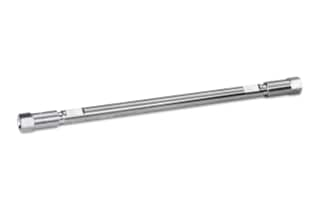
|
Chemistry |
Cation-Exchange |
|
Separation Mode |
Ion-Exchange |
|
Maximum Pressure |
4000 psi (280 Bar) |
|
Particle Shape |
Spherical |
|
Particle Size |
5 µm |
|
Endfitting Type |
Waters |
|
Format |
Column |
|
System |
HPLC |
|
Inner Diameter |
3.9 mm |
|
Length |
150 mm |
|
UNSPSC |
41115709 |
|
Brand |
IC-Pak |
|
Product Type |
Columns |
|
Units per Package |
1 pk |

IC-Pak Cation M/D Column, 3.9 mm x 150 mm, 1/pk
Waters offers a range of products aimed not only to simplify ion chromatography, but also to provide innovative capillary electrophoresis products for ion analysis. As anions and cations are typically measured in separate processes, IC-Pak columns allow for both to occur across a full range of ions from numerous sample matrices, both simple and complex.
Designed to allow chromatographers to simultaneously analyze monovalent and divalent cations under isocratic conditions, the IC-Pak Cation M/D Column allows for quantitation of Na+, K+, Li+, and NH4+ cations. This is done while providing analytical chemists the most sensitive means possible of analyzing these monovalent cations. IC-Pak Cation columns use a sulfonated styrene-divinylbenzene-based resin to perform this analysis and separate a full range of ions from complex sample matrices. They also offer an exceptional linear loading range, starting at less than 1.0 ppb and going up to 400 ppm without dilution or pH limitations on eluent or sample.
Paired with other lab equipment like the Acrodisc, Syringe Filter, IC, 13 mm, 0.45 µm, Ion Chromatography, 100/pk, the IC-Pak Cation M/D Column allows for cation analysis that is accurate and reproducible at all concentration levels, offering identical elution order profiles. The IC-Pack Cation M/D column allows for the separation of alkali and alkaline earths more efficiently than other IC-Pak Cation columns as well as separation of ethanolamine-related organic cations. Additionally, monovalent and divalent cations can be analyzed in two separate runs with different mobile phase compositions used for the two analyses.
What Is The Difference Between Anions And Cations?
Anions and cations are both found in ions, which are charged atoms with an unbalanced number of electrons and protons. These can be found in two forms: anions and cations. A cation has more protons than electrons, resulting in a net positive charge. A cation forms when one or more electrons are lost, usually having been pulled away by atoms with a stronger affinity for them. An anion has more electrons than protons, meaning they have a net negative charge. An anion will form when one or more electrons are gained, having been pulled away from other atoms with a weaker affinity for them. Ion-exchange chromatography relies on the affinity of these molecules being separated in order for the stationary phase to allow for separation.